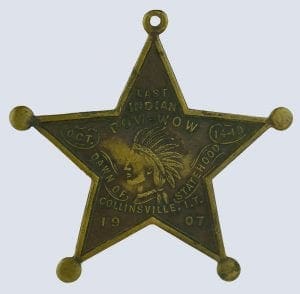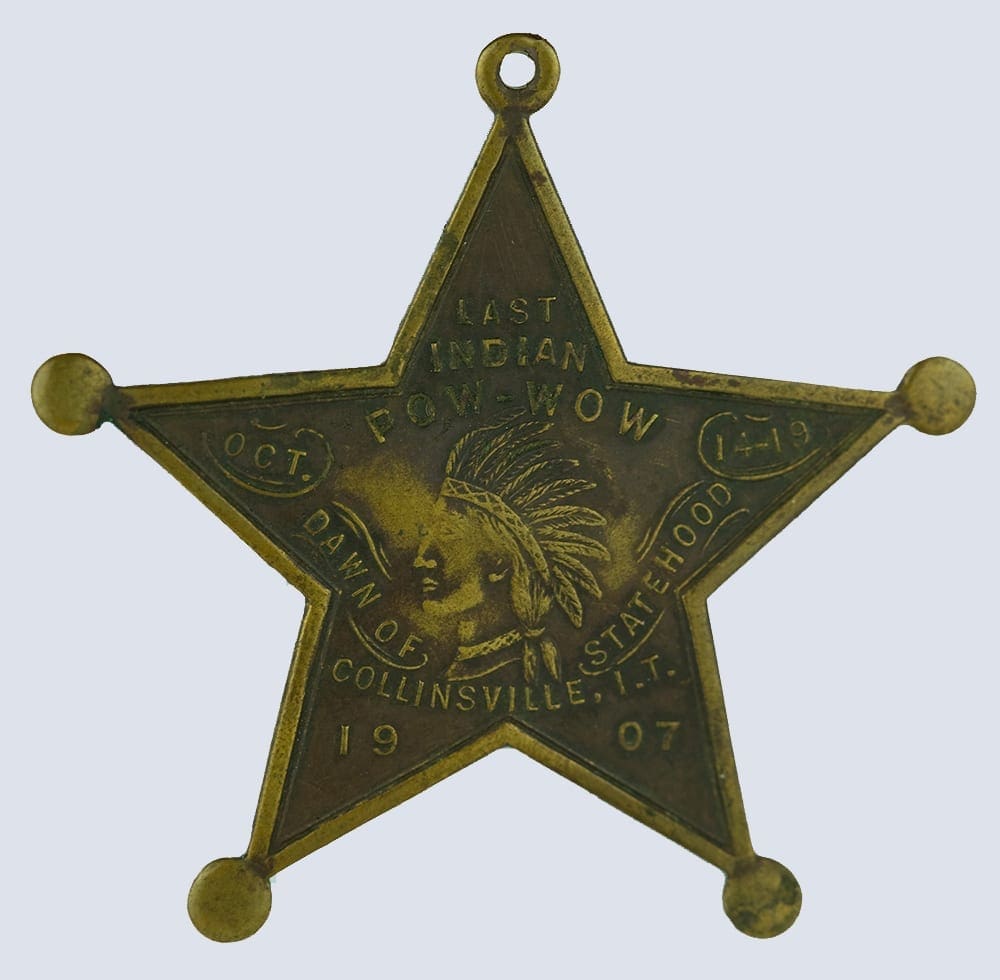 In October 1907, Collinsville, Indian Territory (now Oklahoma), was the site of an event billed as “the last great powwow before [Oklahoma] statehood.” Hosted by Shawnee chief Henry Spybuck, tribal members from throughout Oklahoma came to participate in traditional ceremonies. The attendance of Geronimo, chief of the Apaches, was fuel for much newspaper fodder, as he was being held as a prisoner of war at Fort Sill in Lawton, Oklahoma. According to the Indian Republicannewspaper (Tulsa, Oklahoma), the U.S. government granted Geronimo and other Apache Indians living on Fort Sill’s “military reservation” permission to travel to the powwow, under escort of armed soldiers. Other chiefs at the powwow included Cherokee chief William Charles Rogers, Osage chief O lo co wah la, Comanche chief Quanah Parker, and Kiowa chief Lone Wolf.
In October 1907, Collinsville, Indian Territory (now Oklahoma), was the site of an event billed as “the last great powwow before [Oklahoma] statehood.” Hosted by Shawnee chief Henry Spybuck, tribal members from throughout Oklahoma came to participate in traditional ceremonies. The attendance of Geronimo, chief of the Apaches, was fuel for much newspaper fodder, as he was being held as a prisoner of war at Fort Sill in Lawton, Oklahoma. According to the Indian Republicannewspaper (Tulsa, Oklahoma), the U.S. government granted Geronimo and other Apache Indians living on Fort Sill’s “military reservation” permission to travel to the powwow, under escort of armed soldiers. Other chiefs at the powwow included Cherokee chief William Charles Rogers, Osage chief O lo co wah la, Comanche chief Quanah Parker, and Kiowa chief Lone Wolf.
This souvenir badge from the 1907 powwow is part of the Shiloh Museum’s William Guy Howard Collection. Howard (1876-1965) moved to Northwest Arkansas from Nebraska as a young boy. He had a lifetime of public service in Springdale as city attorney during World War I, mayor during World War II, and municipal judge in the 1950s. To many local folks, Howard was known simply as “the Judge.” He was also a collector of prehistoric and Native American artifacts, which he displayed floor-to-ceiling in his home. In 1966 the Springdale City Council voted to purchase Howard’s massive collection of some 10,000 prehistoric and historic artifacts and 260 books and pamphlets on anthropology and archeology. This was the founding collection of the Shiloh Museum.
In October 1907, Collinsville, Indian Territory (now Oklahoma), was the site of an event billed as “the last great powwow before [Oklahoma] statehood.” Hosted by Shawnee chief Henry Spybuck, tribal members from throughout Oklahoma came to participate in traditional ceremonies. The attendance of Geronimo, chief of the Apaches, was fuel for much newspaper fodder, as he was being held as a prisoner of war at Fort Sill in Lawton, Oklahoma. According to the Indian Republican newspaper (Tulsa, Oklahoma), the U.S. government granted Geronimo and other Apache Indians living on Fort Sill’s “military reservation” permission to travel to the powwow, under escort of armed soldiers. Other chiefs at the powwow included Cherokee chief William Charles Rogers, Osage chief O lo co wah la, Comanche chief Quanah Parker, and Kiowa chief Lone Wolf.
This souvenir badge from the 1907 powwow is part of the Shiloh Museum’s William Guy Howard Collection. Howard (1876-1965) moved to Northwest Arkansas from Nebraska as a young boy. He had a lifetime of public service in Springdale as city attorney during World War I, mayor during World War II, and municipal judge in the 1950s. To many local folks, Howard was known simply as “the Judge.” He was also a collector of prehistoric and Native American artifacts, which he displayed floor-to-ceiling in his home. In 1966 the Springdale City Council voted to purchase Howard’s massive collection of some 10,000 prehistoric and historic artifacts and 260 books and pamphlets on anthropology and archeology. This was the founding collection of the Shiloh Museum.

